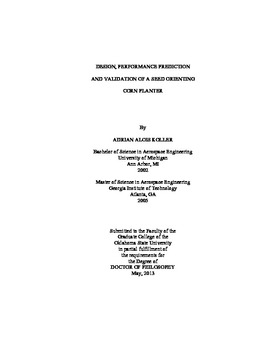| dc.contributor.advisor | Buser, Michael D. | |
| dc.contributor.author | Koller, Adrian Alois | |
| dc.date.accessioned | 2014-09-24T14:16:33Z | |
| dc.date.available | 2014-09-24T14:16:33Z | |
| dc.date.issued | 2013-05-01 | |
| dc.identifier.uri | https://hdl.handle.net/11244/10970 | |
| dc.description.abstract | Investigations into active control of corn canopy architecture through manipulation of seed orientation at planting have shown that specific seed orientations produce highly aligned leaf azimuths. Data obtained from hand planted field trials with across-row oriented leaves show that such canopies intercept more light and ultimately produce higher yields. This study was conducted to investigate the feasibility of mechanized seed orientation through the concept of part orientation by pushing. 3D-scans of 15 "medium flat" kernels of the hybrids DKC-6342, DKC-6346, P0902HR and P1162HR have been computationally analyzed to determine stable seed orientations when subjected to pushing. These predicted results were compared to data obtained in bench tests. The concept was then refined and integrated into a prototype planter based on a standard off-the-shelf row unit. The prototype was first tested in a soil bin at laboratory conditions and then in the field. Because field tests do not allow measurement of seed orientations directly greenhouse studies of the relationship between seed orientation and seed leaf azimuth distributions were conducted to assess the feasibility of an indirect post-emergence performance measure. The computational model was able to predict seed orientation by pushing very accurately. The analysis and subsequent bench unit and prototype tests revealed that orientation performance is dependent on seed shape with the kernels of DKC-6342 being the most and those of P1162HR the least suitable. Soil bin and field data confirmed that at least parity between seed and ground velocity must be achieved in order to maintain orientation during transition from the orientation mechanism to the ground. The greenhouse studies led to the conclusion that seed-to-leaf azimuth distributions can be described by von Mises models. Due to the specific design of the orienter, the shape of the kernels, and the observed seed-to-leaf azimuth properties the measureable seed leaf azimuth distribution in the field is expected to be a von Mises mixture containing four modes. The complexity of such a mixture inhibits the accurate, indirect determination of seed orientation performance in the field. | |
| dc.format | application/pdf | |
| dc.language | en_US | |
| dc.publisher | Oklahoma State University | |
| dc.rights | Copyright is held by the author who has granted the Oklahoma State University Library the non-exclusive right to share this material in its institutional repository. Contact Digital Library Services at lib-dls@okstate.edu or 405-744-9161 for the permission policy on the use, reproduction or distribution of this material. | |
| dc.title | Design, Performance Prediction and Validation of a Seed Orienting Corn Planter | |
| dc.type | text | |
| dc.contributor.committeeMember | Taylor, Randal K. | |
| dc.contributor.committeeMember | Weckler, Paul R. | |
| dc.contributor.committeeMember | Raun, William Robert | |
| osu.filename | Koller_okstate_0664D_12768.pdf | |
| osu.accesstype | Open Access | |
| dc.description.department | Biosystems & Agricultural Engineering | |
| dc.type.genre | Dissertation | |
